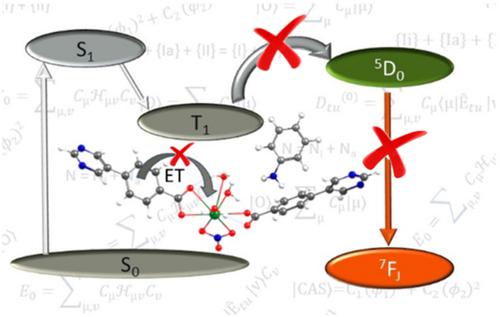当前位置:
X-MOL 学术
›
J. Comput. Chem.
›
论文详情
Our official English website, www.x-mol.net, welcomes your feedback! (Note: you will need to create a separate account there.)
Sensing mechanism elucidation of a europium( III ) metal–organic framework selective to aniline: A theoretical insight by means of multiconfigurational calculations
Journal of Computational Chemistry ( IF 3 ) Pub Date : 2020-06-19 , DOI: 10.1002/jcc.26365 Yoan Hidalgo-Rosa 1, 2 , Manuel A Treto-Suárez 1 , Eduardo Schott 2, 3 , Ximena Zarate 4 , Dayán Páez-Hernández 1, 5
Journal of Computational Chemistry ( IF 3 ) Pub Date : 2020-06-19 , DOI: 10.1002/jcc.26365 Yoan Hidalgo-Rosa 1, 2 , Manuel A Treto-Suárez 1 , Eduardo Schott 2, 3 , Ximena Zarate 4 , Dayán Páez-Hernández 1, 5
Affiliation

|
A theoretical procedure, via quantum chemical computations, to elucidate the detection principle of the turn‐off luminescence mechanism of an Eu‐based Metal‐Organic Framework sensor (Eu‐MOF) selective to aniline, is accomplished. The energy transfer channels that take place in the Eu‐MOF, as well as understanding the luminescence quenching by aniline, were investigated using the well‐known and accurate multiconfigurational ab initio methods along with sTD‐DFT. Based on multireference calculations, the sensitization pathway from the ligand (antenna) to the lanthanide was assessed in detail, that is, intersystem crossing (ISC) from the S1 to the T1 state of the ligand, with subsequent energy transfer to the 5D0 state of Eu3+. Finally, emission from the 5D0 state to the 7FJ state is clearly evidenced. Otherwise, the interaction of Eu‐MOF with aniline produces a mixture of the electronic states of both systems, where molecular orbitals on aniline now appear in the active space. Consequently, a stabilization of the T1 state of the antenna is observed, blocking the energy transfer to the 5D0 state of Eu3+, leading to a non‐emissive deactivation. Finally, in this paper, it was demonstrated that the host‐guest interactions, which are not taken frequently into account by previous reports, and the employment of high‐level theoretical approaches are imperative to raise new concepts that explain the sensing mechanism associated to chemical sensors.
中文翻译:

对苯胺有选择性的铕 (III) 金属-有机骨架的传感机制阐明:通过多构型计算的理论见解
完成了通过量子化学计算阐明对苯胺具有选择性的 Eu 基金属有机框架传感器 (Eu-MOF) 关闭发光机制的检测原理的理论程序。使用众所周知且准确的多构型 ab initio 方法以及 sTD-DFT 研究了 Eu-MOF 中发生的能量转移通道,以及了解苯胺的发光猝灭。基于多参考计算,详细评估了从配体(天线)到镧系元素的敏化途径,即从配体的 S1 到 T1 状态的系统间交叉(ISC),随后能量转移到 5D0 状态Eu3+。最后,清楚地证明了从 5D0 状态到 7FJ 状态的发射。除此以外,Eu-MOF 与苯胺的相互作用产生了两个系统的电子态的混合,苯胺上的分子轨道现在出现在活性空间中。因此,观察到天线的 T1 状态稳定,阻止能量转移到 Eu3+ 的 5D0 状态,导致非发射失活。最后,在本文中,证明了以前的报告中没有经常考虑的主客体相互作用以及高级理论方法的使用对于提出解释与化学相关的传感机制的新概念是必不可少的。传感器。阻止能量转移到 Eu3+ 的 5D0 状态,导致非发射失活。最后,在本文中,证明了以前的报告中没有经常考虑的主客体相互作用以及高级理论方法的使用对于提出解释与化学相关的传感机制的新概念是必不可少的。传感器。阻止能量转移到 Eu3+ 的 5D0 状态,导致非发射失活。最后,在本文中,证明了以前的报告中没有经常考虑的主客体相互作用以及高级理论方法的使用对于提出解释与化学相关的传感机制的新概念是必不可少的。传感器。
更新日期:2020-06-19
中文翻译:

对苯胺有选择性的铕 (III) 金属-有机骨架的传感机制阐明:通过多构型计算的理论见解
完成了通过量子化学计算阐明对苯胺具有选择性的 Eu 基金属有机框架传感器 (Eu-MOF) 关闭发光机制的检测原理的理论程序。使用众所周知且准确的多构型 ab initio 方法以及 sTD-DFT 研究了 Eu-MOF 中发生的能量转移通道,以及了解苯胺的发光猝灭。基于多参考计算,详细评估了从配体(天线)到镧系元素的敏化途径,即从配体的 S1 到 T1 状态的系统间交叉(ISC),随后能量转移到 5D0 状态Eu3+。最后,清楚地证明了从 5D0 状态到 7FJ 状态的发射。除此以外,Eu-MOF 与苯胺的相互作用产生了两个系统的电子态的混合,苯胺上的分子轨道现在出现在活性空间中。因此,观察到天线的 T1 状态稳定,阻止能量转移到 Eu3+ 的 5D0 状态,导致非发射失活。最后,在本文中,证明了以前的报告中没有经常考虑的主客体相互作用以及高级理论方法的使用对于提出解释与化学相关的传感机制的新概念是必不可少的。传感器。阻止能量转移到 Eu3+ 的 5D0 状态,导致非发射失活。最后,在本文中,证明了以前的报告中没有经常考虑的主客体相互作用以及高级理论方法的使用对于提出解释与化学相关的传感机制的新概念是必不可少的。传感器。阻止能量转移到 Eu3+ 的 5D0 状态,导致非发射失活。最后,在本文中,证明了以前的报告中没有经常考虑的主客体相互作用以及高级理论方法的使用对于提出解释与化学相关的传感机制的新概念是必不可少的。传感器。



























 京公网安备 11010802027423号
京公网安备 11010802027423号